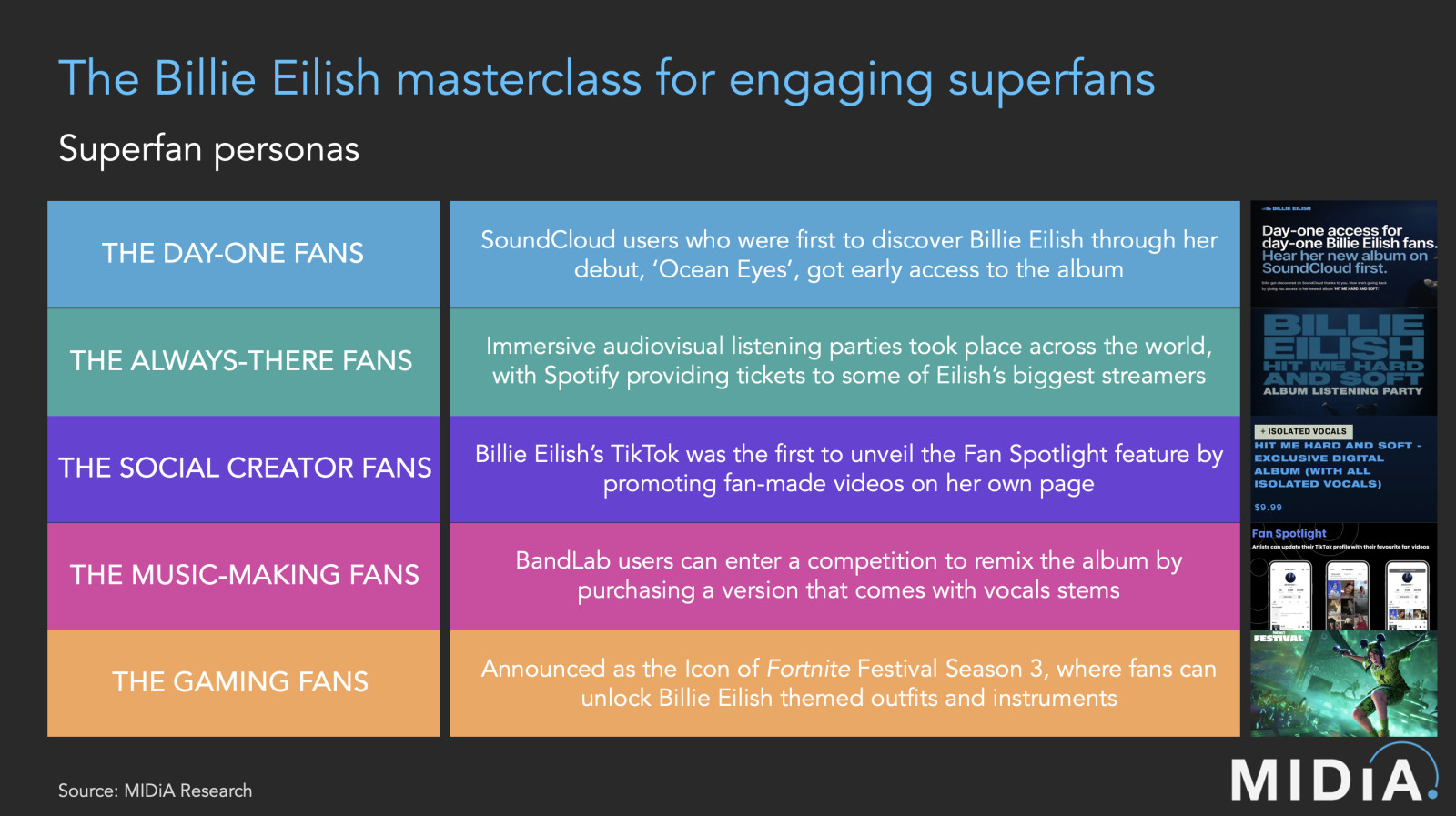Billie Eilish delivered a superfan masterclass


While the industry standard for new releases has long been about scale and velocity, Billie Eilish, her brother Finneas, and Darkroom/Interscope, the labels behind their latest album Hit Me Hard and Soft, have delivered a masterclass in executing a superfan-focused release strategy.
Recognising the diversity of superfan personas was a primary contributor to the effectiveness of the release. It is no longer practical to look at superfans as a monolith. Instead, they must be viewed through the lens of each persona.
The ‘day-one fans’
‘Day-one fans’ are the first to discover and fall in love with a new artist. These are perhaps the most valuable fans for any artist's career, yet there has not been a clear path to reaching and celebrating them. However, that has all changed following SoundCloud’s partnership with Eilish. Her latest album was released in full on the platform, and a number of her earliest followers were showcased on SoundCloud’s Hit Me Hard and Soft landing page.
Eilish released her first song, ‘Ocean Eyes’, on SoundCloud in late 2015. At the start of 2016, Eilish only had around 7,000 followers on the platform. Now she has 2.24 million SoundCloud followers. Instead of those first few thousand fans getting lost in the millions, the release of Hit Me Hard and Soft shows they can be recognised and rewarded, a fundamental foundation of building the superfan economy.
The ‘always-there fans’
In 2023, MIDiA released its live music report, we found that the primary reason for a fan buying a ticket to see an artist was because they were one of their favourites and they ‘could not miss it’. Although most fans are not necessarily there from day one, there are still plenty who simply can not miss their favourite artist. These are the ‘always-there fans’ – they can always be counted on to turn up for both live and online.
These are the fans Eilish relied on for the immersive listening parties that took place across the world in support of Hit Me Hard and Soft. Whilst SoundCloud rewarded day-one fans, Spotify rewarded the heaviest streamers with an opportunity to access tickets. Streaming is not the only way fans express fandom, but reaching those devoting most of their attention to an artist is crucial in turning fans into superfans.
Featured Report
Pixels to playlists Music preferences and behaviours of gamers
The global games industry is a $236.9 billion behemoth. It now rivals film, television, and music combined in terms of revenues and is a cultural driver. Yet, for music companies, labels, and platforms,...
Find out more…The ‘music-making fans’
Making music is an extension of fandom. We regularly see this in our surveys, with those who make music being amongst the most active music fans. Engaging ‘music-making fans’ is becoming increasingly important as more consumers pick up lean in behaviours.
Eilish and her brother Finneas, who produces the majority of her work, have always been good at engaging fellow music producers. With the release of Hit Me Hard and Soft, the duo gave producers the chance to remix vocal stems from the album as part of a BandLab competition. Remixing is perhaps the most immersive way of experiencing music, so giving superfans a chance to put their mark on the new album was an ingenious way to engage ‘music-making fans’.
The ‘social creator fans’
While most consumers now use social media, only a minority are creators. However, those who lean in to superfan behaviours are more likely to list “creating content” among their top reasons to use social platforms. Consumers who buy vinyl, merch, and gig tickets are almost twice as likely to do this compared to the average consumer.
Given these facts, it was unsurprising to see Eilish’s label engaging ‘social-creator fans’ in the release of Hit Me Hard and Soft. This was done by creating a bigger incentive to make content through TikTok’s Spotlight feature. Now that fan-made videos can be presented on the artist’s own TikTok page, there is an opportunity for fans to not only be recognised by an artist they love but also promoted to their audience of millions.
The ‘gamer fans’
Prior to the release of Hit Me Hard and Soft, Eilish was announced as the icon of Fortnite Festival Season 3. This meant that Fortnite players could pay to unlock Eilish’s virtual outfits and instruments along with jamming to a selection of her tracks. This partnership highlights that reaching gamers is no longer a niche strategy for the music industry; it is now an essential channel for reaching and capitalising on superfans.
In-game item spending is particularly important since vinyl and merch buyers were more than twice as likely as the average consumer to have bought in-game items in 2023. However, it is also a key channel for reaching music producers, who present a $100 million in-game spending opportunity. Music creation tools in gaming environments are already here, it is now down to rightsholders to reach gamers by developing artist-led tools for superfans.
The superfan effect
Hit Me Hard and Soft is Billie Eilish’s most commercially successful debut week in the charts. However, it is also the first time she has not debuted at number one. Holding that place is arguably the master of super fandom, Taylor Swift, who still holds the top spot with The Tortured Poets Department. However, what both Swift and Eilish have in common is releasing their albums with minimal promotion of singles in the build-up to release. Instead, the focus has been on bringing superfans to the album rather than a particular song.
The key theme across all these superfan personas is the need to capture a minimum threshold of attention. Superfandom is not a passive experience and the shift in focus from singles to albums puts more onus on the listener to discover the music and narrative for themselves. Hit Me Hard and Soft is, in Eilish’s words, an “album-ass album” and perhaps the biggest learning is that for superfans, “album-ass albums” still matter.

There are comments on this post join the discussion.